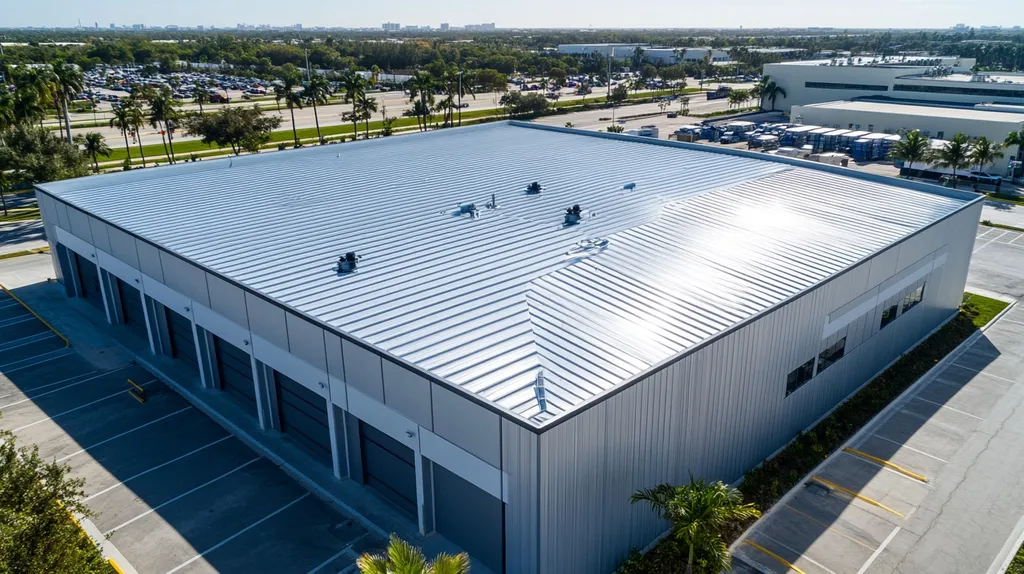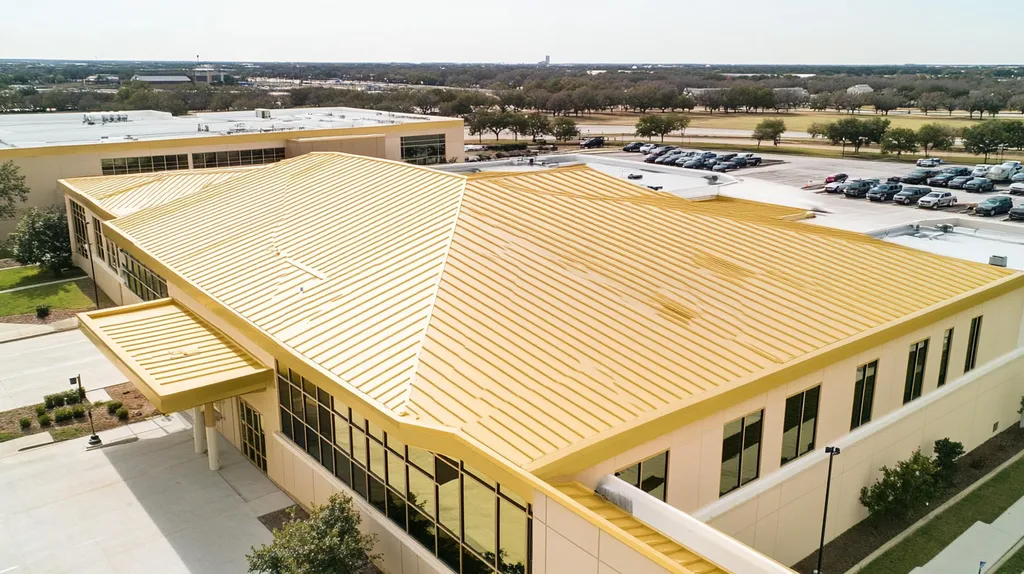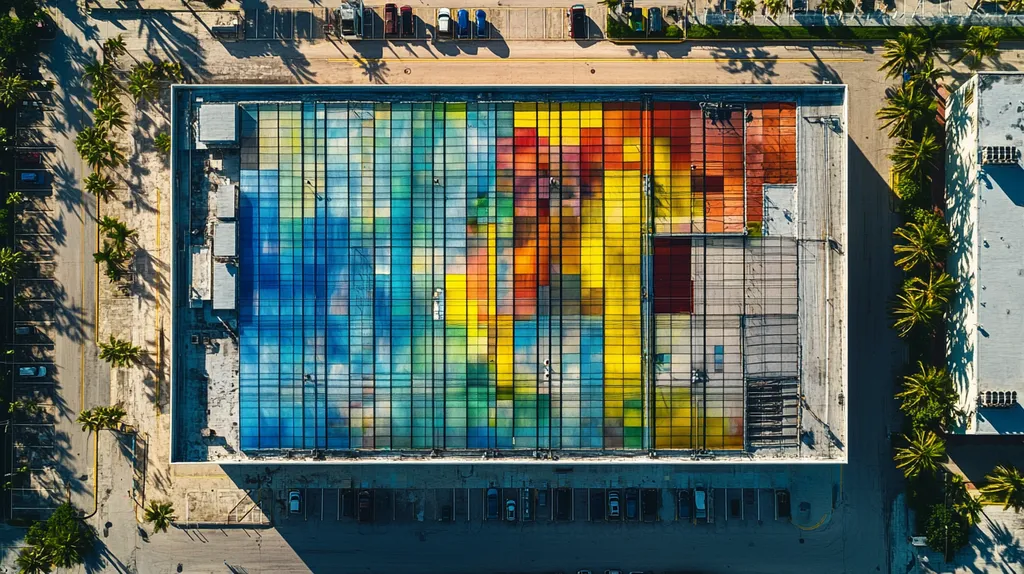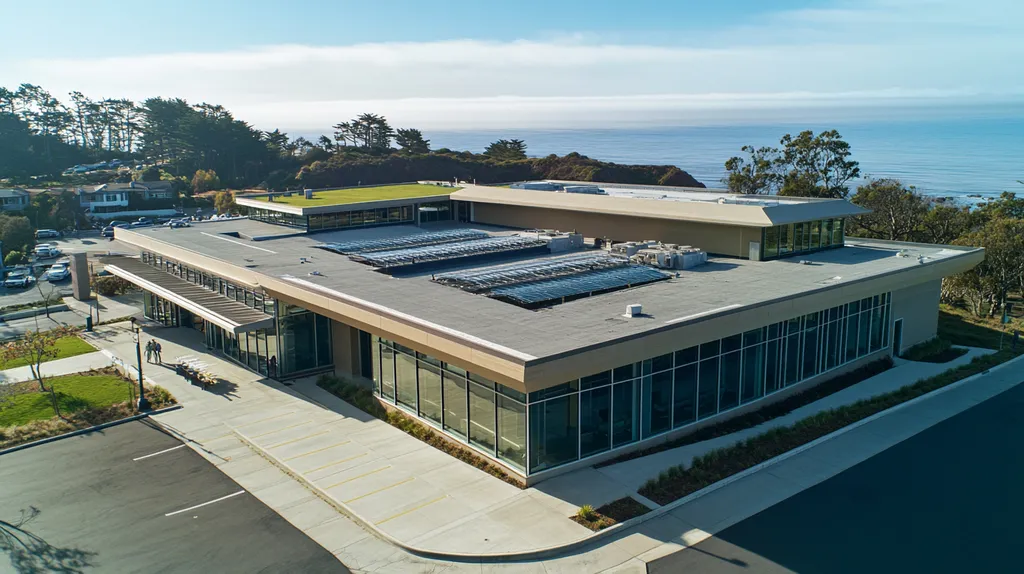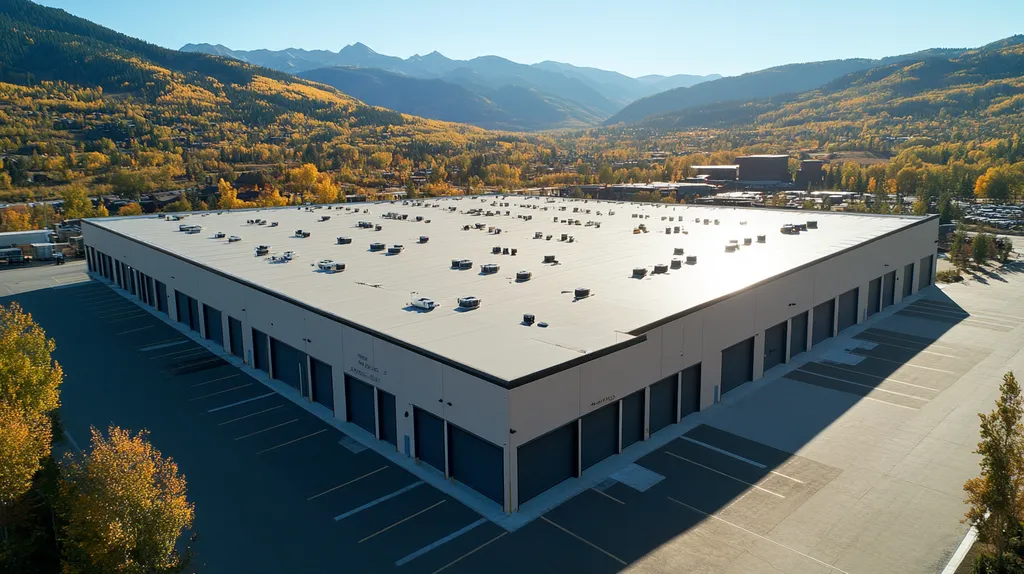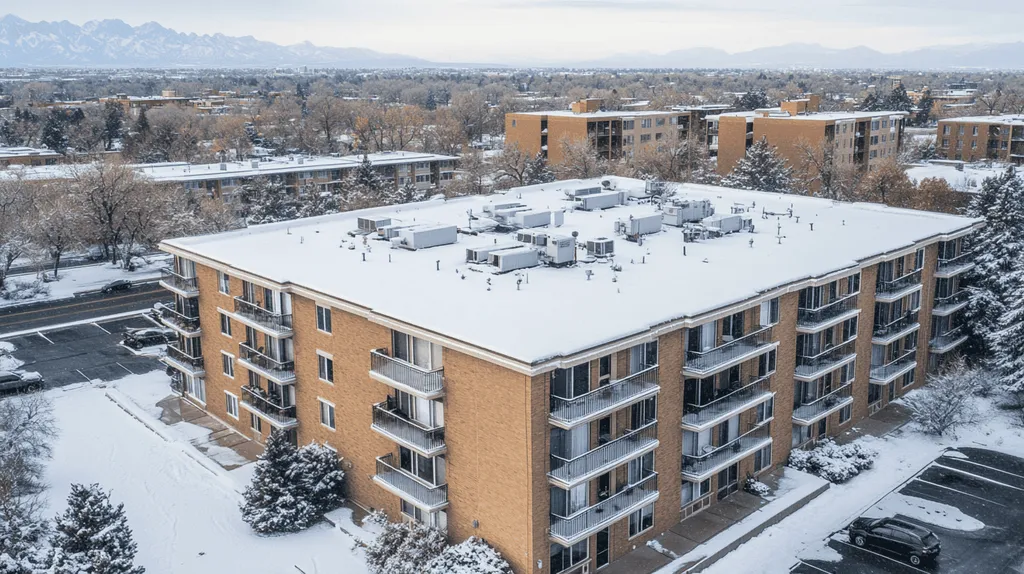Drainage issues account for over 40% of commercial roof failures, resulting in billions of dollars in damage annually across North America. Despite this staggering statistic, many property owners continue to overlook critical drainage requirements.
Left unchecked, poor drainage leads to accelerated material deterioration, compromised structural integrity, and costly emergency repairs that can disrupt business operations.
This comprehensive guide examines common misconceptions about commercial roof drainage while providing evidence-based solutions for property owners and facility managers to protect their investments and extend roof lifespans.
SECTION 1: COMMON MISCONCEPTIONS
Misunderstanding drainage on commercial roofs can result in significant financial consequences and costly repairs. A startling 20% of commercial roofs encounter drainage issues, underscoring the urgency of addressing popular misconceptions. By clearing up these myths, property owners and facility managers can make better-informed decisions that protect their investments and maintain the integrity of their buildings.
Flat Roofs Are Completely Flat
Many believe that flat roofs are just that—completely flat. However, these roofs typically feature a slight slope designed to facilitate effective drainage. A truly flat surface would result in water accumulation, significantly heightening the risk of leaks and structural damage.
To prevent this, manufacturers recommend a minimum slope of 1% to 2%, ensuring water flows effectively. Overlooking this critical detail can lead to stagnant water, which wears down roofing materials over time. Misunderstanding roof slope can also affect design choices and inspections.
Property owners should recognize that an appearance of flatness does not eliminate the need for careful evaluation. Regularly assessing roofs helps catch potential drainage problems early, allowing for timely mitigation. Ultimately, acknowledging that flat roofs have a necessary slope is essential for maintaining proper drainage and preventing expensive repairs.
Ponding Water Is Not a Big Deal
Another prevalent myth is that standing water on roofs does not pose a serious threat. In reality, ponding water can lead to significant issues if left unaddressed. Experts recommend that water should not remain on the roof for longer than 48 hours.
Persistent standing water can damage roofing materials and foster leaks and mold growth within the building. Studies suggest that prolonged water accumulation can reduce a roof’s lifespan by nearly 50%.
Property owners often delay addressing this issue until substantial damage occurs, making swift action imperative. By maintaining efficient drainage systems, they protect not just the roof but also the overall structural integrity of the building.
Understanding the dangers of ponding water encourages proactive maintenance, ultimately saving money and enhancing property values.
No Need for Regular Inspections
The notion that commercial roofs do not require regular inspections is a dangerous fallacy. Conducting routine evaluations is vital for spotting potential drainage issues before they escalate. Professionals recommend inspecting roofs at least twice a year and following significant weather events.
Neglecting these inspections can result in undetected damage, leading to expensive repairs that could have been prevented. Alarmingly, 40% of roofing failures relate directly to a lack of maintenance and inspection.
Regular inspections enable facility managers to identify issues such as clogged drains and insufficient slopes early on. Implementing a preventive maintenance schedule can substantially extend a roof’s lifespan and minimize costly downtime.
In summary, prioritizing regular inspections is critical for effective drainage management, protecting both the roof and the investment represented by the property.
SECTION 2: PRACTICAL IMPLICATIONS
Understanding the implications of drainage on commercial roofs is essential for ensuring their longevity and durability. Poor drainage often leads to ponding water, which can inflict severe and costly damage over time. Alarmingly, nearly 50% of commercial roof failures stem directly from insufficient drainage systems. This section delves into the impact of ponding, how inadequate drainage harms roofing materials, and the heightened risk of leaks and structural damage.
Impact of Ponding on Roof Integrity
Ponding water is a significant threat to the structural integrity of commercial roofs. When water collects, it adds excess weight, potentially exceeding the load limits designed for the roof. For instance, just one inch of standing water can add about 5 to 15 pounds per square foot, depending on the roofing system.
This additional weight can place undue stress on vital components like seams and fasteners, accelerating the deterioration of the roof. Furthermore, standing water accelerates the aging process of roofing materials, leading to a dramatically reduced lifespan. Regular inspections focused on areas prone to ponding are crucial for addressing these problems before they worsen.
Neglecting the issue of ponding can significantly escalate repair costs and may even necessitate an unplanned roof replacement well ahead of schedule. Facility managers must invest in effective drainage solutions to mitigate these risks and protect their financial investments.
Effects of Poor Drainage on Roof Materials
Commercial roofing systems rely on specific materials designed to perform under optimal conditions. However, poor drainage can hasten the deterioration of these materials. For example, water pooling can weaken the adhesion of EPDM and TPO membranes, creating vulnerabilities that can compromise the roof’s effectiveness.
Moreover, standing water can become a breeding ground for mold and algae, leading to unpleasant odors and potential health concerns. Materials such as modified bitumen may crack and peel when subjected to persistent water accumulation, resulting in further complications.
In essence, the deterioration of roofing materials caused by inadequate drainage practices can generate unexpected expenses for property owners. Investing in quality drainage solutions not only prolongs the lifespan of the roofing system but also helps maintain material integrity.
Increased Risk of Leaks and Structural Damage
Failing to address drainage issues significantly raises the likelihood of leaks and structural damage. Ponding water provides an ideal environment for leaks to develop, with even minor cracks potentially escalating into major problems. Once water breaches the roof system, it can travel along seams, wreaking havoc throughout the structure.
The consequences of leaks extend beyond immediate water damage, affecting crucial assets within commercial properties. Electrical systems and HVAC components are particularly vulnerable to water intrusion, which can jeopardize both equipment functionality and safety.
In addition to immediate leaks, unresolved drainage issues can compromise the roof’s load-bearing capacity over time. Regular maintenance of drainage systems is essential to prevent mounting repair costs and to uphold overall property value.
SECTION 3: COST OF MISINFORMATION
The financial implications of ignoring proper drainage maintenance on commercial roofs are significant. Many property owners underestimate how neglecting this aspect can impact their bottom line and property value. Research from the National Roofing Contractors Association shows that inadequate drainage can shorten a roof’s lifespan by up to 50%. Addressing the cost of misinformation about drainage practices is vital to safeguarding investments.
Financial Consequences of Neglected Maintenance
Ineffective drainage systems can lead to dire financial consequences. When water accumulates, it not only damages the roof but can also necessitate expensive emergency repairs. Property owners may find themselves facing bills ranging from thousands to tens of thousands of dollars.
For instance, a single significant leak may compromise insulation, requiring its replacement. This can further escalate costs when hydrophobic materials must be treated for mold or replaced altogether.
Unforeseen repairs can disrupt business operations, leading to increased liability risks and a loss of income. The financial strain from neglected drainage practices is not just a one-time issue; it compounds over time.
Investing in proactive maintenance can effectively avert these costs, helping to protect the roof’s integrity. Thoughtful planning in maintenance transforms spending from an expense into an investment in long-term savings.
Cost of Repairing vs. Replacing the Roof
Understanding when to repair versus when to replace a roof is crucial for effective decision-making. Persistent drainage issues often lead to costly repairs that demand immediate attention. However, consistently paying for repairs can quickly add up, making roof replacement a more financially sound option in the long run.
For example, while an initial patch-up of a leaking roof may seem economical, ongoing water damage reduces structural integrity and can necessitate a complete roof replacement, which is far more expensive.
The long-term financial implications of misunderstanding drainage needs can lead to premature roof replacement. Property owners must carefully balance immediate repair costs with the potential for significant long-term liabilities.
By making informed decisions about roof maintenance and drainage solutions, owners can avoid this costly cycle. Regular evaluations and a maintenance strategy can effectively maximize financial resources while extending the roof’s lifespan.
Loss of Energy Efficiency and HVAC Performance
Inefficient drainage management negatively influences energy usage and HVAC performance. When standing water collects on roofs, it raises the surrounding temperature, forcing HVAC systems to operate at greater capacity, leading to increased energy costs.
Moreover, stagnant water can damage insulation materials, diminishing their effectiveness. This reduced efficiency not only inflates heating and cooling expenses but can also shorten the lifespan of HVAC systems.
Research indicates that poorly maintained roofs can cause energy costs to soar by as much as 30% (source: Commercial Roofing Best Practices: Essential Tips for Durability). Such increases have a direct impact on a property’s operating budget, further emphasizing the need for effective drainage management.
Enhancing drainage systems can lead to improved energy efficiency, contributing to a more sustainable environment while simultaneously reducing ongoing operational expenses.
SECTION 4: REALITY CHECK
Understanding drainage on commercial roofs is critical for protecting property investments and ensuring safety. Poor drainage can lead to pooling water, which is responsible for nearly 70% of roofing failures, according to industry studies. Recognizing actual slope requirements and implementing effective drainage systems can significantly mitigate risks and enhance the life of a roof. This section will examine vital components of effective drainage and their implications for commercial roofing.
Actual Slope Requirements for Flat Roofs
Flat roofs are often mistakenly thought to need no slope, which can lead to major drainage problems. In reality, a minimum slope of 1% to 2% is essential for proper water drainage. This slight incline encourages water to flow towards designated drainage points, significantly reducing the chance of pooling.
Neglecting these slope requirements can create hidden hazards. Standing water may lead to leaks, mold growth, and structural damage, jeopardizing the roof’s integrity and resulting in expensive repair bills and lost business time.
Local building codes also often stipulate specific slope requirements that property owners must follow. Ignoring these regulations can lead not only to legal repercussions but also to financial penalties, highlighting the necessity of consulting knowledgeable roofing professionals.
Understanding these slope requirements is crucial for property owners. Investing in a properly sloped roof can save substantial costs in maintenance and repairs over time.
Importance of Proper Drainage Systems
An effective drainage system is vital for managing water flow on commercial roofs. This system includes components like gutters, downspouts, and drainage membranes that work together to divert water away from the roof. Without these systems, rainwater can accumulate and cause significant ponding.
Proper drainage doesn’t just prevent overflow; it also enhances the roof’s longevity. A well-designed drainage system can extend the lifespan of roofing materials by preventing the accumulation of harmful environmental stressors. Indeed, roofs with effective drainage can endure up to 50% longer than those lacking such systems.
Utilizing advanced drainage strategies, such as tapered insulation, can optimize water flow by creating a controlled slope that directs water efficiently toward drainage points.
The financial repercussions of neglecting drainage systems are substantial. Over time, water damage can escalate repair costs and diminish the overall value of the building. Ensuring proper drainage is a sound investment for any commercial property.
Role of Crickets in Enhancing Roof Slope
Crickets are essential yet often overlooked features in flat roofing designs. These small, angled structures are placed around roof protrusions, such as chimneys and vents, to effectively channel water toward drainage points. Their function in improving roof slope is crucial for efficient water management.
Without crickets, water can easily pool around these protrusions, greatly increasing the chance of leaks and water intrusion. This localized water accumulation can rapidly deteriorate roofing materials and create additional maintenance challenges.
Incorporating crickets into a roofing design not only enhances efficiency but also aligns with best practices in roof construction. When properly installed, crickets minimize water accumulation risks and extend the overall lifespan of the roofing system.
Given the preventative benefits they provide, crickets should be a standard consideration during the roofing design phase. This simple addition can yield significant long-term benefits for commercial property owners.
SECTION 5: EVIDENCE-BASED ALTERNATIVES
As commercial roofs face increasingly extreme weather conditions, effective drainage solutions become paramount. Poor drainage often leads to roof failures, extensive damage, and costly repairs, accounting for nearly 70% of roofing issues. This section explores innovative alternatives designed to enhance drainage, improve energy efficiency, and prolong the lifespan of commercial roofs.
Custom-Fabricated Roofs for Better Drainage
Custom-fabricated roofs are engineered to address specific drainage requirements, offering superior performance compared to standard designs. These tailored roofs can include slopes and drainage systems that effectively direct water away, significantly reducing the risk of ponding—a common precursor to leaks and roof deterioration.
The precision of custom fabrication ensures every aspect aligns with the unique structure of the building, enhancing overall durability and limiting long-term maintenance costs. By implementing tailored drainage solutions, property owners significantly reduce the likelihood of emergency repairs and improve the longevity of their roofing systems.
These custom solutions are especially critical in regions prone to heavy rainfall. Investing in a custom-fabricated roof ensures optimal performance in challenging weather conditions, leading to minimized risk of water damage and an extended roof lifespan.
Benefits of Cool Roofing Systems
Cool roofing systems present a dual benefit: enhanced drainage and improved energy efficiency. Designed to reflect sunlight and absorb less heat, these roofs help moderate surface temperatures, which aids in better drainage and minimizes the risk of water accumulation.
Additionally, cool roofs can lower cooling energy costs by up to 15%. This decrease not only results in significant savings but also supports environmental sustainability by reducing greenhouse gas emissions.
Many cool roofing materials also feature advanced drainage capabilities, ensuring quick water runoff and less opportunity for pooling and potential damage. A well-designed cool roofing system can substantially prolong the roof’s life, making it a strategic investment for commercial property owners.
Targeted Repairs and Overlays for Extended Roof Life
Targeted repairs and overlays can effectively enhance drainage on existing roofs, serving as a compelling alternative to complete roof replacements. Rather than a total overhaul, these methods can extend the roof’s lifespan while simultaneously resolving drainage issues. Conducting timely, targeted repairs allows facility managers to rectify minor concerns before they evolve into more significant problems.
Overlays involve adding a new layer of roofing material over the existing roof, capable of being engineered for better drainage. This approach provides a refreshed surface while saving time and money compared to full reconstruction.
By utilizing these rehabilitation techniques, facility managers can adapt roofs to changing environmental conditions, improving their resilience against heavy rainfall and snow. These strategies not only optimize functionality but also keep long-term maintenance costs in check.
In conclusion, targeted repairs and overlays offer a practical and cost-effective solution to enhance roof performance and manage water effectively, protecting the property’s investment. Implementing a routine inspection schedule to catch minor issues before they escalate further supports these efforts (source: 1800 New Roof).
SECTION 6: TEST AND VERIFY
Effective drainage on commercial roofs is critical for preventing costly water damage and extended repair timelines. Statistics reveal that over 25% of roofing failures result from water pooling issues. Regular assessments, coupled with thorough testing, help to identify and address potential problems before they escalate into major concerns. This section outlines the essential practices for effective roof inspections, water flow testing, and maintenance protocols that are necessary for upholding roof warranties.
Regular Inspection Protocols for Commercial Roofs
Establishing a routine inspection schedule is fundamental for successful roof maintenance. Inspections should occur at least biannually, preferably in spring and fall, to correspond with seasonal weather shifts. Early identification of issues such as debris buildup or material deterioration is crucial for avoiding larger problems.
Post-storm evaluations are equally important. Weather events like heavy rain, high winds, or snow can impact drainage systems, potentially hiding damage that may worsen over time. By promptly addressing these impacts, property managers can maintain the structural integrity of the roof.
A thorough inspection checklist should involve assessing drainage systems, examining seams, and inspecting flashings. Employing trained roofing professionals ensures that even the smallest detail is not overlooked during evaluations. Additionally, documentation of all inspections helps track the roof’s condition and supports necessary repairs down the line.
Regular inspections not only extend the life of the roof but also enhance the overall property value. Proactive maintenance demonstrates responsibility and attracts prospective tenants or buyers, reinforcing the importance of maintaining a sound roof.
Testing for Proper Water Flow and Drainage
Testing for adequate water flow is essential in identifying and rectifying drainage issues. Simple ponding tests can reveal areas of inadequate slope or potential blockages in drainage pathways. Conducting these tests during rainfall simulations allows for real-time observations of water movement across the roof.
Visual inspections of drainage components, including scuppers and gutters, should be integrated into testing. Inspectors must check for debris or blockages, ensuring that water is effectively diverted away from the building. Implementing these tests is crucial for preventing water accumulation and related damage.
Advanced techniques, such as infrared thermography, can also aid in identifying moisture trapped beneath the roof membrane. This technology detects temperature inconsistencies signaling potential water infiltration, enabling swift intervention before damage escalates.
Regular testing is vital for effective stormwater management. By swiftly identifying and addressing small drainage issues, property owners can avert major repair needs and enhance the longevity of the entire roof system.
Maintaining Roof Warranties Through Regular Care
Proper drainage management is integral not only for roof protection but also for meeting manufacturer warranty requirements. Many warranties stipulate that regular maintenance and inspection records are essential to validate claims for significant repairs. Failing to adhere to these guidelines can lead to warranty disputes when issues arise.
Routine cleaning and maintenance often uncover minor problems that could invalidate warranties if ignored. For instance, simple debris blockages can escalate into severe drainage issues and compromise warranty terms. Property owners must meticulously document all maintenance tasks and inspections to support any future warranty claims.
Engaging qualified roofing professionals for routine maintenance ensures compliance with warranty specifications. Their expertise can help navigate complex manufacturer guidelines related to roof performance standards.
Ultimately, consistent maintenance fosters a trusting relationship between property owners and contractors while securing significant investments. A proactive approach not only protects warranties but also maximizes roofing performance over the long term.
The Bottom Line
With over 40% of commercial roof failures directly attributed to drainage issues, the financial stakes for property owners have never been higher.
Proper drainage management represents the difference between a roof lasting its full 20-30 year lifespan and requiring premature replacement at significant cost.
Regular inspections, properly maintained slope, and functional drainage systems are not optional – they are essential requirements for protecting commercial roofing investments.
Moving forward, facility managers must prioritize drainage through evidence-based maintenance protocols, professional inspections, and prompt repairs when issues arise.
The cost of ignoring these fundamentals – both in terms of repairs and decreased property value – far exceeds the investment required for proper drainage maintenance.
FREQUENTLY ASKED QUESTIONS
Q. Are flat roofs completely flat regarding commercial roof drainage?
A. Flat roofs are not entirely flat; they have a slight slope for drainage. This slope, typically between 1% and 2%, ensures water flows efficiently to drainage points, preventing ponding and associated damage.
Q. How does ponding water affect the integrity of an industrial roof?
A. Ponding water adds excess weight to industrial roofs and can lead to significant damage. With just one inch of standing water adding 5 to 15 pounds per square foot, this can stress roofing materials and shorten their lifespan.
Q. What are the financial consequences of neglecting commercial roof maintenance?
A. Neglecting maintenance can lead to significant financial burdens due to emergency repair costs and potential revenue loss. These expenses accumulate over time and can result in bills that range from thousands to tens of thousands of dollars.
Q. What slope is recommended for effective drainage on flat roofs?
A. A slope of 1% to 2% is essential for effective water drainage on flat roofs. This incline directs water towards drainage systems, significantly reducing the risk of pooling and related water damage.
Q. What are the benefits of using cool roofing systems on commercial roofs?
A. Cool roofing systems reflect sunlight, reducing heat absorption and improving energy efficiency. They help manage water drainage effectively and can lower cooling costs by up to 15%, enhancing overall roof longevity.
Q. How often should commercial roofs be inspected for drainage issues?
A. Commercial roofs should be inspected at least twice a year, ideally in spring and fall. These routine evaluations help identify potential drainage issues, preventing significant damage and maintaining the roof’s structural integrity.
Q. What role do crickets play in commercial roofing drainage?
A. Crickets are angled structures that help channel water away from roof protrusions like chimneys and vents. They enhance drainage efficiency and prevent water from pooling, which can lead to damage and leaks.

